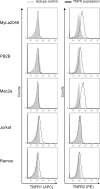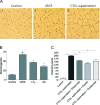Malignant T cells express lymphotoxin α and drive endothelial activation in cutaneous T cell lymphoma
- PMID: 25915535
- PMCID: PMC4558148
- DOI: 10.18632/oncotarget.3837
Malignant T cells express lymphotoxin α and drive endothelial activation in cutaneous T cell lymphoma
Abstract
Lymphotoxin α (LTα) plays a key role in the formation of lymphatic vasculature and secondary lymphoid structures. Cutaneous T cell lymphoma (CTCL) is the most common primary lymphoma of the skin and in advanced stages, malignant T cells spreads through the lymphatic to regional lymph nodes to internal organs and blood. Yet, little is known about the mechanism of the CTCL dissemination. Here, we show that CTCL cells express LTα in situ and that LTα expression is driven by aberrantly activated JAK3/STAT5 pathway. Importantly, via TNF receptor 2, LTα functions as an autocrine factor by stimulating expression of IL-6 in the malignant cells. LTα and IL-6, together with VEGF promote angiogenesis by inducing endothelial cell sprouting and tube formation. Thus, we propose that LTα plays a role in malignant angiogenesis and disease progression in CTCL and may serve as a therapeutic target in this disease.
Keywords: CTCL; LTA; angiogenesis.
Conflict of interest statement
The authors declare no competing interests.
Figures







References
-
- Willemze R, Jaffe ES, Burg G, Cerroni L, Berti E, Swerdlow SH, Ralfkiaer E, Chimenti S, Diaz-Perez JL, Duncan LM, Grange F, Harris NL, Kempf W, et al. WHO-EORTC classification for cutaneous lymphomas. Blood. 2005;105:3768–3785. - PubMed
-
- Girardi M, Heald P, Wilson L. The pathogenesis of mycosis fungoides. N.Engl.J.Med. 2004;350:1978–1988. - PubMed
-
- Hwang ST, Janik JE, Jaffe ES, Wilson WH. Mycosis fungoides and Sezary syndrome. Lancet. 2008;371:945–957. - PubMed
-
- Kim E, Lin J, Junkins-Hopkins J, Vittorio C, Rook A. Mycosis fungoides and sezary syndrome: an update. Curr.Oncol.Rep. 2006;8:376–386. - PubMed
-
- Duvic M, Foss FM. Mycosis fungoides: Pathophysiology and emerging therapies. Semin. Oncol. 2007;34:21–27. - PubMed
Publication types
MeSH terms
Substances
Grants and funding
LinkOut - more resources
Full Text Sources
Other Literature Sources
Medical
Miscellaneous

